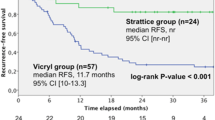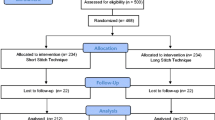Abstract
Purpose
To compare the results of abdominal wall closure using interrupted synthetic short-term vs. long-term tensile strength-retaining absorbable sutures.
Methods
The subjects were 55 patients undergoing elective laparotomy through a midline vertical incision for gastric or colon cancer surgery between November 2008 and August 2010, at our hospital. After providing informed consent, the patients were randomized for suturing with Polysorb®, which provides short-term tensile strength, or with PDS®II, which provides long-term strength. The primary outcome analyzed was the incidence of incisional hernia or wound dehiscence.
Result
There were 28 patients allocated to the Polysorb group and 27 to the PDS II group. Postoperative wound dehiscence was noted in two patients (3.6 %). Five of 51 patients (9.8 %) suffered incisional hernia within 1 year after surgery, 6 of 41 patients (14.6 %) within 2 years, and 6 of 35 patients (17.1 %) within 3 years. There was no significant per year difference in the incidence of incisional hernia or wound dehiscence between the groups.
Conclusion
Outcomes were favorable in both groups and not inferior to reported outcomes of larger-scale studies. Verification of the equivalence between the two types of suture material necessitates larger-scale studies that adopt the same suture methods.

Similar content being viewed by others
References
Rath AM, Chevrel JP. The healing of laparotomies: review of the literature. Part 1. Physiologic and pathologic aspects. Hernia. 1998;2:145–9.
Van’t Riet M, Steyerberg EW, Nellensteyn J, Bonjer HJ, Jeekel J. Meta-analysis of techniques for closure of midline abdominal incisions. Br J Surg. 2002;89:1350–6.
Diener MK, Voss S, Jensen K, Buchler MW, Seiler CM. Elective midline laparotomy closure: the INLINE systematic review and meta-analysis. Ann Surg. 2010;251:843–56.
Hodgson NC, Malthaner RA, Ostbye T. The search for an ideal method of abdominal fascial closure: a meta-analysis. Ann Surg. 2000;231:436–42.
Hsiao WC, Young KC, Wang ST, Lin PW. Incisional hernia after laparotomy: prospective randomized comparison between early-absorbable and late-absorbable suture materials. World J Surg. 2000;24:747–51.
Wissing J, van Vroonhoven TJ, Schattenkerk ME, Veen HF, Ponsen RJ, Jeekel J. Fascia closure after midline laparotomy: result of a randomized trial. Br J Surg. 1987;74:738–41.
Corman ML, Veidenheimer MC, Coller JA. Controlled clinical trial of three suture materials for abdominal wall closure after bowel operation. Am J Surg. 1981;141:510–3.
Justinger C, Slotta JE, Schilling MK. Incision hernia after abdominal closure with slowly absorbable versus fast absorbable, antibacterial-coated sutures. Surgery. 2012;151:398–403.
Author information
Authors and Affiliations
Corresponding author
Rights and permissions
About this article
Cite this article
Ohira, G., Kawahira, H., Miyauchi, H. et al. Synthetic polyglycomer short-term absorbable sutures vs. polydioxanone long-term absorbable sutures for preventing incisional hernia and wound dehiscence after abdominal wall closure: a comparative randomized study of patients treated for gastric or colon cancer. Surg Today 45, 841–845 (2015). https://doi.org/10.1007/s00595-014-1103-1
Received:
Accepted:
Published:
Issue Date:
DOI: https://doi.org/10.1007/s00595-014-1103-1




